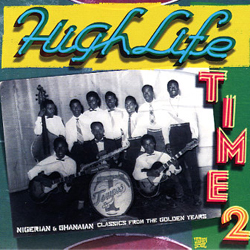by Various
More Nigerian and Ghanaian highlife classics on the second volume of Vampisoul’s comprehensive series. This new selection guides the listener into the highlife world far enough to show the many different angles and approaches representing this irresistible music. Featuring tracks by essential artists of the genre such as ET Mensah & The Tempos, Dr Victor Olaiya, Prince Nico Mbarga, Dr Sir Warrior, Rex Lawson and more.
Professor John Collins (musician, composer, prolific writer about African music and eminent musicologist at the University of Ghana) has traced the roots of highlife music back to the 1880s on the Gold Coast, now known as Ghana. He sees it as a fusion of rhythms from the West African coast, from Europe, from the Caribbean and from African Americans in both South and North America.
Nigerian journalist Benson Idonije, however, is by no means alone in believing that while Mensah must be saluted for the cultural legacy he left behind, he was not responsible for introducing highlife to Nigeria: "Highlife has always been with us (Nigerians), at least since the guitar or mandolin banjo was introduced to our folk and indigenous music to bring about its very first contact with Western instrumentation and music. That type of music just did not attract the kind of mass appeal that Mensah's Tempos band generated."
Highlife became the fashionable soundtrack to independence in both countries (Ghana 1957, Nigeria 1960) and an essential foundation to the new musical styles that were to develop, but as the 60s rolled on the music evolved differently in each country, diverging as different forces came into play. However, in both countries economics meant that big highlife bands were difficult to maintain, and the ever growing popularity of the electric guitar, aided and abetted by the sounds of the successive waves of the beat, blues and rock booms from the USA and the UK, meant that guitar highlife became a very cool direction to take. Rex Lawson and Sir Victor Uwaifo led the development of the guitaroriented variant of highlife, but the terrible crisis of the 1967-70 Nigerian (or Biafran) Civil War brought its own set of musical changes.
This week's Top 10:
